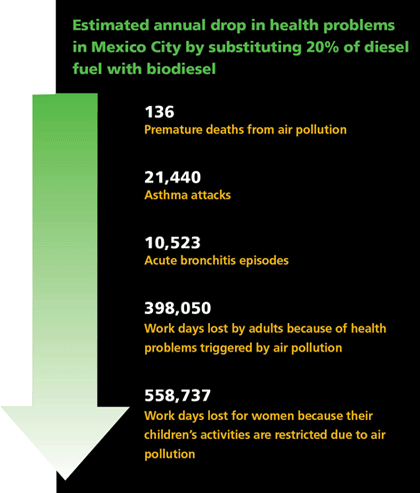[ Winter 2011]
HSPH student sees the future of energy production—and cleaner, healthier skies—in tiny green algae
Birds no longer fall dead out of the sky in Mexico City. One of the most polluted spots on Earth 20 years ago—when it was dubbed “Makesicko City” by novelist Carlos Fuentes—the city is emerging from the thick blanket of smog that afflicted residents with ailments ranging from irritated eyes and headaches to asthma, heart disease, and lung cancer. Actions taken by the Mexican government to reduce emissions were praised by international experts as a model for the developing world.
But as this sprawling metropolis of 20 million people—and 4 million vehicles—continues to grow, new solutions must be found to keep it moving in a healthy and sustainable direction. Harvard School of Public Health doctoral student Ramon Sanchez, who will graduate in 2011 with a degree in environmental health, sees hope for the massive energy needs of Mexico City, and the rest of the world, in a new and sustainable source of biofuel: algae.
AIR POLLUTION: 2 MILLION DEATHS YEARLY
According to the World Health Organization, air pollution causes approximately 2 million premature deaths worldwide each year. More than half of the disease burden from air pollution strikes in developing countries. WHO recommends lowering concentrations of several of the most common air contaminants emitted during the combustion of fossil fuels to reduce air pollution and improve health. Converting to cleaner-burning fuels derived from biomass such as algae, fermented corn and soybeans, or recycled cooking oil would help achieve this goal.
In Mexico City, changing fuel for 165,000 diesel vehicles to biodiesel would go a long way toward reducing the amount of dangerous airborne particulates breathed in by its residents. For his thesis, Sanchez is using pollutant emissions and statistical models to study the potential health effects of such a change. Even increasing the proportion of biodiesel by just 20 percent, he says, would make a dramatic difference in the prevention of cardiopulmonary diseases and lung cancer, which could save the Mexican health system approximately $90 million annually. With Mexico pledging to reduce its carbon footprint by 50 percent by 2050 and having just hosted the December 2010 United Nations Climate Change Conference, the political climate could be ripe for such a change.
Acquiring data is key to making an objective case for changing energy policy, says Sanchez. A mechanical engineer, he took up the cause of biofuels while working in the automotive industry. But he lacked the tools to quantify why switching to cleaner fuel made good public health and economic sense.
“It’s not enough to say, ‘I’m eating organic,’ or, ‘I’m changing my lightbulbs.’ Give me a number,” says Sanchez. “Only an accounting process can tell you what you are really accomplishing.” Renewable energy may be more expensive now, but when taking into account the long-term costs to society in health and environmental damage, petroleum is actually more expensive, he says.
GAME CHANGER
“Ramon’s work is a game changer,” says his adviser, John Spengler, Akira Yamaguchi Professor of Environmental Health and Human Habitation. “Nobody else is looking at the production, cost, and health benefits of biofuels and quantifying them for Mexico.” This is important now, Spengler says, because in addition to the direct health consequences of air pollution, such as cardiovascular and respiratory ailments, the climate warming caused by pollution triggers additional health problems. According to Spengler, the recent uptick in extreme weather events and record temperatures has brought flooding to Pakistan, for example. It has also increased the risk of heatstroke and expanded the habitats of disease-spreading mosquitoes and ticks.
“Public health is all about preventing disease,” Sanchez says. “I intend to prevent disease, but over a long time frame. Reducing carbon dioxide emissions today could prevent someone in Bangladesh from getting sick 40 years from now.”
While he has been completing his studies at HSPH, Sanchez and his twin brother, Jose, who earned an SM in environmental health management from HSPH in 2005, have been laying the groundwork for a microalgae farming operation back home in Mexico. Grown in ponds or other aquatic systems, microalgae thrive on carbon dioxide while pumping oxygen into the atmosphere. Unlike biofuel derived from corn and soybeans, algae farming doesn’t imperil the food supply. It uses far fewer resources—operations can be launched on marginal lands such as deserts and supplied with wastewater—for a far higher yield. Microalgae produce six times more ethanol than corn, for example, and 40 times more biodiesel than soy. The high-protein residue left behind after the oil is extracted can be used as animal feed. Some strains can be processed to produce oil for human consumption that is rich in healthy omega-3 fatty acids. And as a substantial added benefit, an algae farm built near a high-polluting power plant or oil refinery could scrub the CO2 and other pollutants from the air, making the operation carbon-neutral with significant reductions in other pollutants.
CORPORATIONS DIPPING THEIR TOES
The United States Department of Energy recently recognized the promise of microalgae, awarding $24 million in grants in June to three research groups exploring how to make algae-based biofuels commercially viable. Large corporations are also dipping their toes in the algae pond, in some cases even looking at genetically modified algae to increase production.
Sanchez, who questions what the potential consequences to marine ecosystems could be if genetically modified algae were to escape the production fields, chooses instead to work with local algae strains. This keeps production costs lower and reduces environmental risk, he says. He believes that microalgae currently are capable of supplying 5 percent of the world’s energy within 15 years—if substantial investment were made in infrastructure starting today. But in reality, he predicts it will take between 25 to 30 years.
DEVELOPING COUNTRIES MAY LEAPFROG AHEAD
Real innovation in the use of biofuel is likely to happen in the developing world, Sanchez says. With less invested in the fossil fuels infrastructure than in the U.S., countries like Mexico are more open to new solutions for providing much needed energy to their citizens. Just as many consumers in China and Africa bypassed land lines and went straight to cell phones, developing countries may leapfrog the rest of the world into a clean energy future, according to Sanchez.
If the United States develops the political will to expand its use of biofuel from nonedible crops, Sanchez plans to be ready. Pointing to a raised floor in HSPH’s Department of Environmental Health, which houses its energy-saving heating and cooling system, he says, “This is what your experience of biofuel will be like 50 years from now—you won’t notice the difference. It will be seamless.” But the health benefits will be striking.
Amy Roeder is assistant editor of the Review.
